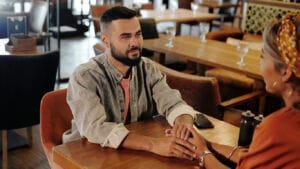A Haunting in Venice opens not just in Venice but in the Venice of someone’s nightmare, in St. Mark’s Square, looking like it does in my dreams (empty for once). A gull kills a pigeon, the film score shrieks, and up in his bed bolts Hercule Poirot, Belgian detective, Kenneth Branagh edition. This is Branagh’s third go at the Agatha Christie character (both playing Poirot and directing the films), and as his giant, silly mustache hit the screen post-horror movie nightmare, the thought began to occur: this could be the first of his adaptations to be fun.
READ ALSO: Read all of Ryan Bordow’s movie reviews here
The previous two, Murder on the Orient Express and Death on the Nile, clearly want to be fun, but they sacrifice camp for gloss—they try for murder mystery parties in exotic locales, but they’re overpolished to the point of anodyne, these oddly toneless vacuums fit for airplane viewing. Their CG landscapes have all the sense of place of a photobooth backdrop, and their stacked casts can’t match the class of the 70s versions (Lauren Bacall! Ingrid Bergman! Vanessa Redgrave!) because modern celebrities have been demystified by the Internet age, or worked in too much Disney shlock, or appeared in that COVID “Imagine” video. Death on the Nile opens with some character—a traumatic origin story for Poirot’s mustache played hilariously straight—but beyond that and Gal Gadot’s bizarrely chipper delivery of “enough champagne to fill the Nile,” it ends up more of the same: not pulp but slick, safe, and unmemorable.
A Haunting, though, has some texture; the title fades in on a sky thick with fog, dispensing with the gloss of its moodless forebears, and a somber score from Hildur Guðnadóttir (Joker, Tár) thrums through Poirot’s nightmare. Between all that and the chiaroscuro lighting—deep dark blacks and flickering lights—this entry starts to feel distinct. Adapting Christie’s Hallowe’en Party, despite its reputation as one of her lesser works, seems to have been the right move.
The story’s been altered a bit: Poirot has retired, ignoring a million requests a day, until his old friend Ariadne—the author who made him famous—turns up with a proposition. There’s going to be a séance in Poirot’s new home of Venice, and the medium performing it has shaken Ariadne’s skepticism; she wants Poirot to rule out the potential supernatural. Willing to expose what he assumes is a sham, Poirot shows up at the palazzo, where a woman prepares to talk to her recently murdered daughter. In the chaos of the séance, which features crashing props and very loud bangs, one of the guests ends up dead.It’s standard horror and standard Poirot, but they blend into something pulpy that the last two films lacked.
The problems with Murder and Death went deeper than lack of mood, though. Their screenplays, adapted from Christie’s more famous mysteries, felt over-condensed and underwritten, heavy on actors but light on character, and half as mysterious as they should be. Despite the possibilities of its narrative liberties, Haunting in Venice eventually crawls the same rut.
Thin characters, introduced hastily, could have any motivation; anyone could be the killer and it’d be equally unsurprising. Clues are either glaringly obvious, pausing a scene’s flow for effect (“Only I have the key to this room” she says in a clunky aside), or they’re hopelessly obscured in the rushed exposition. You don’t get to play detective with Poirot; you get to wait for him to clarify what pieces of dialogue mattered. And once again, the story’s attempts to flesh out Poirot fall flat: we hear that he’s weary, “always around death,” and that his retirement is endemic of a fundamental selfishness, but these ideas are barely followed through on—besides a colder performance from Branagh, Poirot is irreproachable intellectually and morally, and complicating him feels like a self-imposed fool’s game. Either make him less of a genius angel or stop trying to make him more than caricature.
Branagh maintains his visual style from Murder and Death to Haunting in Venice, which means a lot of interesting but disjointed shots. It’s hard to forget Murder’s body discovery scene being shot from a distracting bird’s-eye view, and Haunting features many similar instances of visual disorientation. Some add to the horror by unsettling the frame, like a few unstabilized handheld shots, but others—like the 35th Dutch angle—seem to strain for impact. Several conversations are shot in near-close-up, blurring the Gothic interiors of the palazzo as if the set were being hidden. Key rooms are designed beautifully, and the film shows them off, but it also tends to shoot around the setting. At least Venice isn’t faked like the Nile was in Nile.
The film really feels like more of the same despite being clothed in horror. A different mood can’t give it character, and the cast, though strong, isn’t nearly melodramatic enough to lean into camp. After this séance, I believe in Poirot even less.
★★ (2/5)
Note from the writer: This review was written during the ongoing WGA and SAG-AFTRA strikes. Without the labor of the writers and actors on strike, A Haunting in Venice wouldn’t exist.




